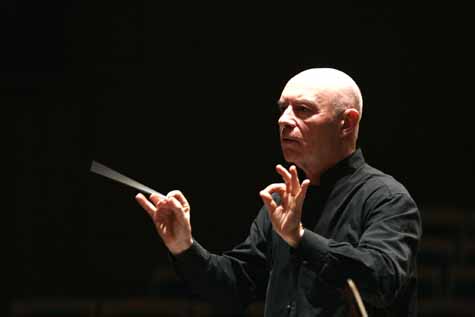Eschenbach, Kremer and NSO deliver powerful Weinberg and Shostakovich

Gidon Kremer performed Mieczysław Weinberg’s Violin Concerto Thursday night with the National Symphony Orchestra.
Thursday night at the Kennedy Center, Christoph Eschenbach and the National Symphony Orchestra continued their “Salute to Slava” (former NSO music director Mstislav Rostropovich) series by offering two Russian works – the Washington premiere of Mieczysław Weinberg’s Violin Concerto in G Minor, Op. 67 and Dimitri Shostakovich’s Eighth Symphony.
Violinist Gidon Kremer introduced his encore of Weinberg’s Prelude by saying that the composer “has still yet to be discovered.” Indeed, the concerto is the first Weinberg work played by the NSO. While 30 years ago Weinberg was practically unheard of, today there are some 100 recordings of his compositions available.
Better late than never. Composed in 1960, the Violin Concerto is charged with breathtaking vitality and lyricism. Shostakovich said, “I remain very impressed with [it]. . . It is a fabulous work.” With its affirmative power and irresistible drive from the first jolt of the Allegro molto to the last diminishing violin chord (ushered out by the horns in triple-pianissimo), it should become a repertoire piece.
This might not have been the performance to make it one – – at least not in the first movement. The headlong whipcrack with which it should have begun simply wasn’t there. Kremer and Eschenbach apparently chose to play the movement more in the manner of a Romantic concerto in an almost mellow, if not tepid way. Where was the propulsive drive designated by the marking? Anyone who had heard the recording of the premiere with violinist Leonid Kogan, for whom it was written, would also wonder where the passion was. Weinberg was sometimes ridiculed as “a little Shostakovich” because of their similarities in style. Kremer certainly did not play the first movement as if it were Shostakovich, and it might have helped if he had. Also, the orchestral textures sounded a little muddy and Kremer’s playing sometimes disappeared in them.
Things improved markedly in the Adagio, which responded well to Kremer’s approach. He did not have the challenge of projecting out from full orchestral tutti, so he was heard to better advantage. In fact, there was some especially exquisite playing in and around the brief cadenza. Kremer achieved intimacy and warmth of expression. The finely shaded playing of both soloist and orchestra revealed the beauty in this music. The lightness of the orchestration in the closing Allegro risoluto also worked to Kremer’s advantage in allowing us to hear his sprightly playing. In the Prelude encore, Kremer may have offered his finest Weinberg performance of the evening.
In his iconoclastic, sometimes ironic symphonic compositions, Shostakovich specialized in using short motifs to rub the listener raw, and no one captured the brutality of banality better than he. These were his weapons, often deployed against his Soviet masters. They must have caught on to what he was doing in the Eighth Symphony because it was soon suppressed.
Shostakovich’s inimitable orchestral language creates certain interpretive challenges. The Leonard Bernstein approach (particularly with the endless repetitions in the Seventh Symphony) was simply to take it over the top. Others choose freneticism or frenzy to drive a work off a cliff. A third choice is simply to play a Shostakovich symphony so well that it succeeds on the level of orchestral execution alone. Eschenbach largely did this with the Eighth Symphony, and the superb playing of the NSO made it possible.

Christoph Eschenbach
This is not to say that there were not interpretive touches. The leisurely tempo with which he began the massive Adagio of the first movement reminded me of Eschenbach’s Bruckner conducting. When the music seemed about to sag under the weight of its thematic repetitions, he would rescue it with some emotive warmth, and the sheer beauty of the NSO string playing served to sustain it. Eschenbach effectively ratcheted things up for the harrowing orchestral screams and crushing climaxes at the end of the central Allegro. In the closing Adagio of the first movement, he took a slower pace to telling effect. The combination of the superb pianissimo strings under the English horn, so expressively played by Kathryn Meany Wilson, achieved a still intensity that was mesmerizing.
In the second and third movements, both Scherzos, the orchestra was razor-sharp. No matter how kaleidoscopic the music became, articulation remained on point. Even when the strings were playing triple forte, Eschenbach kept the textures crystalline. One might think that driving this music even harder would more make more sense of it but, by not doing so, Eschenbach achieved a startling clarity that ironically exposed the underlying insanity of the music just as well.
Shostakovich said that, “The majority of my symphonies are tombstones,” and this was heard nowhere more powerfully than in the elegiac Largo, in which the strings played with great feeling yet in a restrained mournful way, over variations in clarinets, flutes, and solo horn. The repetition of the ground bass proved hypnotic.
As the closing Allegretto demonstrated, power was never absent from this performance, but the luminous closing coda, in which Eschenbach in the NSO gently laid the Eighth Symphony to rest, showed how much they excelled at the subtleties.
The strength of each orchestral section Thursday evening shows that, upon his departure, Eschenbach is leaving a fine legacy for incoming music director Gianandrea Noseda.
The program will be repeated 8 p.m. Friday and Saturday. kennedy-center.org/calendar/event/NRCSH; 202-467-4600.
Robert R. Reilly is the author of Surprised by Beauty: A Listener’s Guide to the Recovery of Modern Music.



